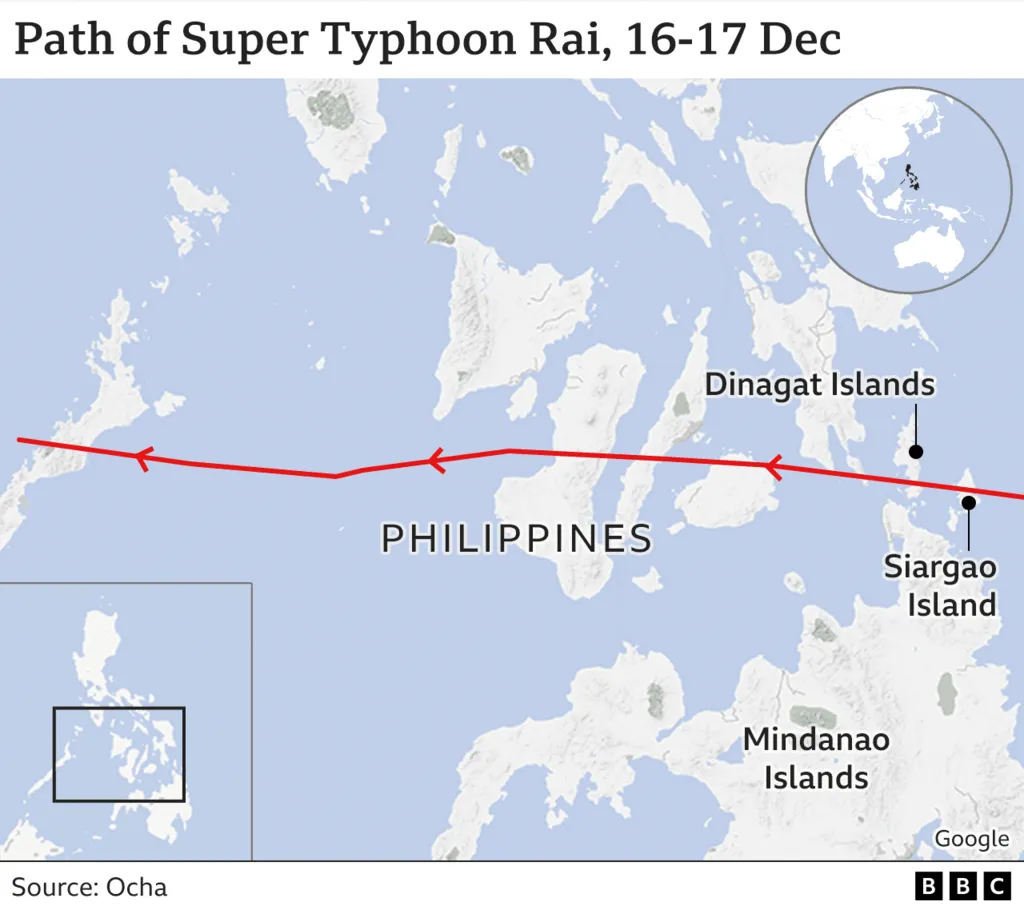From December 16th to 17th, 2021 a category 5 typhoon called Typhoon Rai, locally called Odette, cut through the southern and central Philippines (NASA 2021). With winds speeds of up to 160 miles per hour, the typhoon was the fifteenth to strike the Philippines that year, and the most severe of 2021 as well (NASA 2021 and Mogul 2021 ). Typhoon Rai made eight landfalls across multiple regions in the Philippines (Gutierrez & Acayan 2021). Approximately, 400,000 people were displaced by the storm and approximately 500 people were killed during and in the aftermath of the storm (BBC 2021 and United Nations 2022). 
This is a natural-color image of Typhoon Rai on
the afternoon of December 16, 2021 (NASA 2021).
 |
| Typhoon path (BBC 2021) |
Measures were taken before the typhoon but were not enough to prevent the widespread disaster. For example, only 100,000 people evacuated their homes prior to the typhoon (NASA 2021). It's not that 100,000 is not an impressive feat, but it made up a small portion of the seven million people whose lives were affected by the typhoon (Nasa 2021).
Many of the buildings were not built to withstand extreme weather. Many victims were crushed when the buildings they sought shelter in collapsed (Gutierrez & Acayan 2021). If incidents like this are to be avoided in the future, the Philippines will need to update its building codes and educate residents on how to identify adequate shelter.
Long term effects include malnutrition and domestic peace (United Nations 2022). It is feared that this disaster will increase malnutrition, an issue already prevalent in 53% of the families in the region (United Nations 2022). Furthermore, reports of rape, domestic violence and prostitution in exchange for food hint at long term negative societal impacts (United Nations 2022).
In response to the Typhoon multiple organizations have been effectively utilized to help the affected communities recover. The Red Cross and Red Crescent began raising funds to focus on the long term recovery of the Philippines (BBC 2021). The Philippine military has been mobilized to help provide aid to cut-off communities too (BBC 2021).
To help prevent disasters such as Typhoon Rai from having such high levels of disastrous impacts again, the Philippines Climate Change Commission started to call for local changes to improve the nation's resilience against further climate related disasters (Gutierrez & Acayan 2021). This is a great step forward towards protecting these at risk communities from unnecessary disaster.
 |
| This is an image of houses flattened by Typhoon Rai. They were not built to withstand such storms (Gutierrez & Acayan, 2021). |
The above video contains footage of the damage caused by Typhoon Rai. It also highlights key problems that arose in the immediate aftermath and the perspective of a local resident.
BBC. (2021). Philippines Super Typhoon Rai death toll surges. BBC News. https://www.bbc.com/news/world-asia-59714658
Gutierrez, J., & Acayan, E. (2021). “help us”: After typhoon rai, Miles of destruction and the smell of death. The New York Times. https://www.nytimes.com/2021/12/27/world/asia/philippines-super-typhoon-rai.html
Mogul, R. (2021). Philippines’ typhoon death toll rises further as areas remain cut off. CNN. https://www.cnn.com/2021/12/21/asia/typhoon-rai-philippines-deaths-intl-hnk/index.html
NASA. (2021). Super Typhoon Rai. NASA. https://earthobservatory.nasa.gov/images/149228/super-typhoon-rai
United Nations. (2022). Relief teams fear worsening aftermath of Super Typhoon Rai | UN News. United Nations. https://news.un.org/en/story/2022/01/1109302
No comments:
Post a Comment
Note: Only a member of this blog may post a comment.